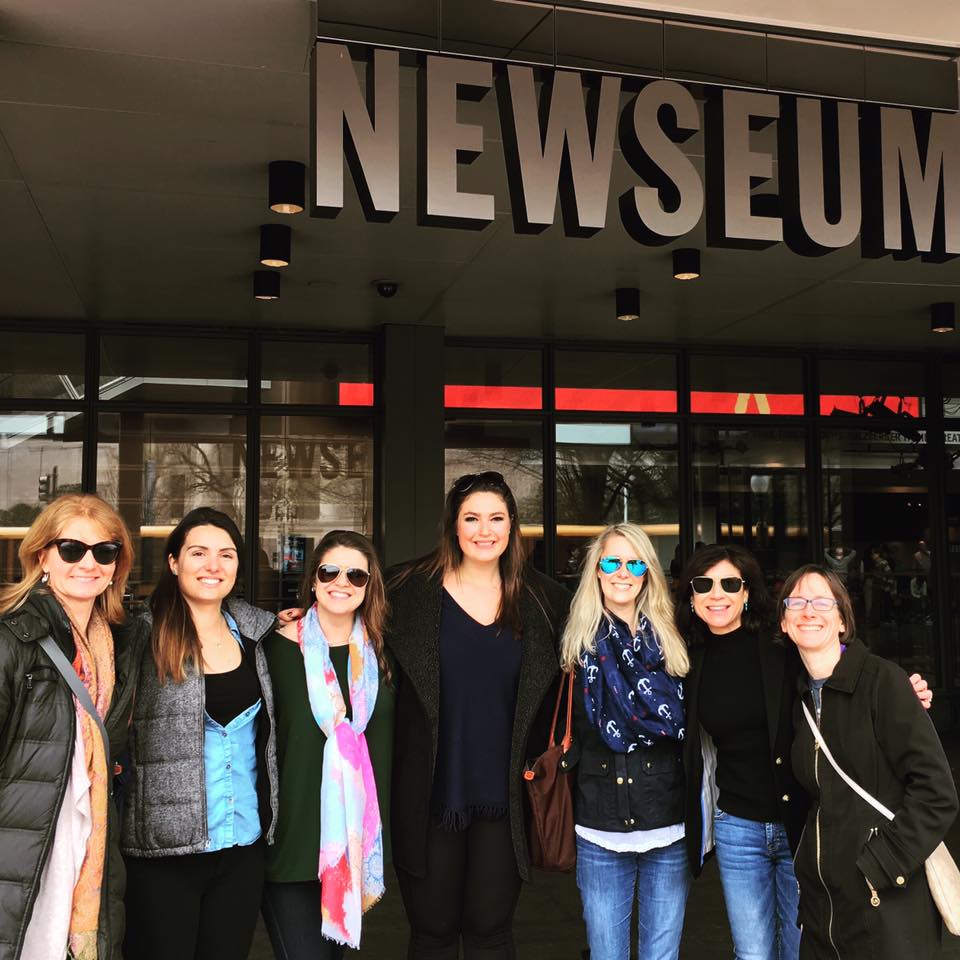
The Teak Team traveled to Washington, D.C. to celebrate our 20th anniversary
To celebrate the 20th anniversary of Teak Media + Communication, the whole team took a trip to Washington, D.C. to visit the Newseum. The institution was opened in 2008 to celebrate the important, and necessary, role of journalism in the world. Communication artifacts are everywhere, including graffiti on giant chunks of the Berlin Wall, an outdated live truck and news helicopter, and a piece of a World Trade Center antenna that somehow survived the fall of the towers on September 11, 2001. Yet, our trip came at a time when journalism itself has increasingly become part of the story in a way that makes its future hard to predict.
There are many reminders in the Newseum that underscore the reality that the gift of a free press shouldn’t be taken for granted. The names of hundreds of journalists who died doing their jobs are etched on glass panels stretching two stories high. The World Press Freedom map, updated by the Freedom House annually, is a grim, 36 foot wide testimonial of the fact that six out of seven people live in places where press is only partially free or not free at all. They have found only 13 percent of the world’s population live in a place with a free press, a place where the safety of journalists is guaranteed and they are allowed to work free of political, legal or economic pressure. Forty one percent have a partially free press. In a wide stretch that covers most of Africa and Asia, 46 percent (3.4 billion people) live in media environments that are not free. North Korea has the worst score; Norway has the best.
In the United States, freedom of the press is one of five freedoms enshrined in the Bill of Rights, which sits under glass in the National Archives, just blocks away from the Newseum. However, even the U.S. score has worsened in recent years due to political and economic factors. Indeed, there is reason to have concern about the future of our beloved First Amendment, as the current administration has attempted to restrict the media’s access to its press conferences. Such actions have caused the Newseum to organize a forum on April 12 about the status of the First Amendment in the first 100 days of the Trump Administration.
Another exhibit traces how the method of delivering information has evolved from printed words on a yellowing front page and scratchy clips of radio broadcasts delivered from the front lines of battlefields to televised live presidential debates, colorful and interactive online articles, and short 140-character tweets.
As the distance and time between information and the audience has shrunk, the need to be critical consumers of the news is increasingly important. Having a seemingly infinite number of news sources to choose from has led many to live in political silos where they only listen to outlets featuring people who share their views, what is referred to as an echo chamber. The introduction of phrases like “fake news” and “alternative facts” as part of the vernacular has led to stories being labeled as false, requiring even more attention from the audience to parse each word and phrase to differentiate between fact and fiction. We left wondering if the next exhibit will be about whether the impact of the misleading effects of echo chambers shaped the 2016 presidential election, and what this means for the future of democracy and journalism.
Yet, there are also numerous beautiful and emotional examples of how the printed word and captured image share information and tell stories that are worth the effort necessary to understand and absorb them.
The Newseum has a gallery full of Pulitzer Prize-winning photographs – vivid images that often evoke emotion and inspire action. It’s impossible to see the portrait of a young, starving child in Africa being watched by a nearby vulture and not want to do something to help; or, to see an ill Babe Ruth leaning on his bat for support at his last appearance at Yankee Stadium without getting goosebumps. As 1969 Pulitzer Prize-winning photographer Eddie Adams said, “If it makes you laugh, if it makes you cry, if it rips out your heart, that’s a good picture.”
Perhaps the most hopeful display at the Newseum is the long case that lines the front of the building containing that day’s front pages from newspapers from all 50 states. There is a similar display inside the museum showing front pages from international papers. These cases are updated each day and serve as an important and constant reminder that with each sunrise, journalists have new pages to fill, new rundowns to stack, new stories to tell, and a new chance to get it right.


